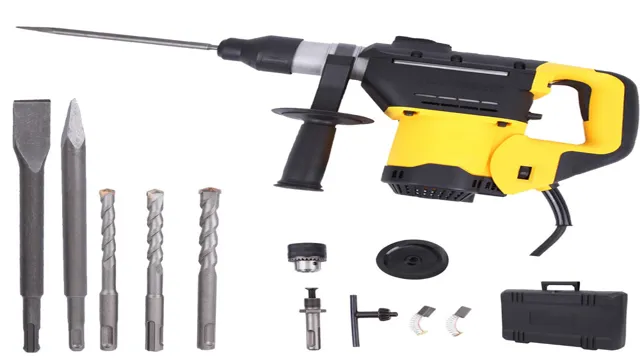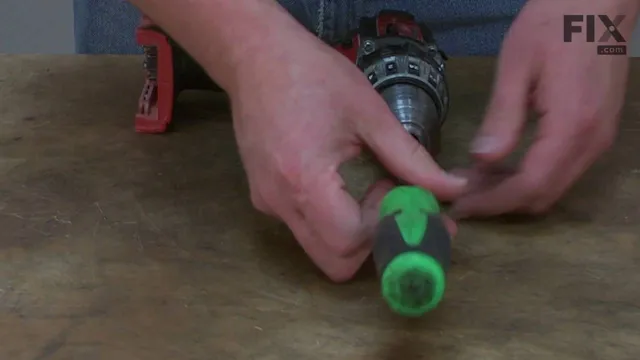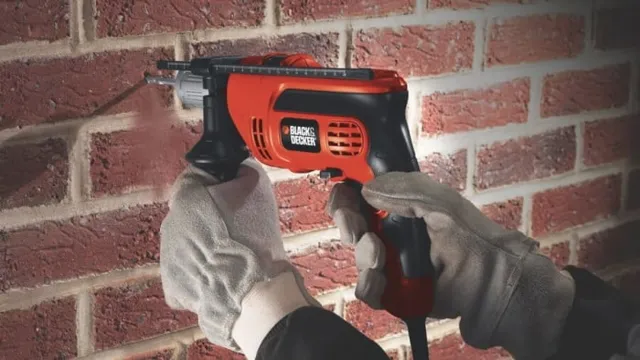Can You Use a Hammer Drill as an Impact Driver? The Ultimate Comparison Guide.
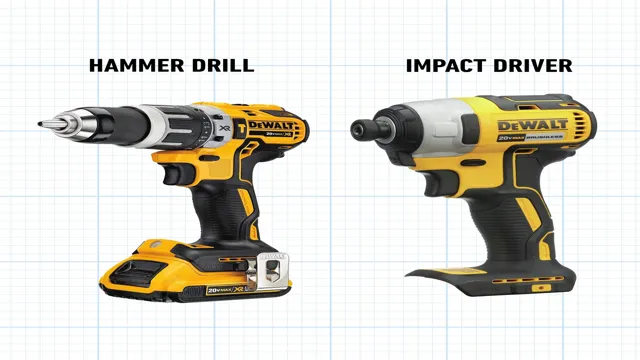
Are you tired of lugging around multiple power tools for your DIY projects? As a handy person, you want to make your life easier and invest in tools that can multitask. This brings us to the question: can you use a hammer drill as an impact driver? Both tools are essential for drilling and fastening tasks, but they have different functions. A hammer drill is designed to drill through hard surfaces like concrete, stones, and brick and can be used with or without a hammer function.
On the other hand, an impact driver is ideal for screwing and unscrewing tasks, providing high torque and precision without stripping screws. While they may sound interchangeable, they have different features and uses. However, some hammer drills can be used as an impact driver with the right bit.
In this blog, we’ll dive deeper into the differences between the two tools and whether you can convert a hammer drill into an impact driver and vice versa. Stay tuned to learn more about the versatility of these power tools and how to make the most out of your DIY projects without breaking the bank.
Understanding Hammer Drills and Impact Drivers
Yes, you can use a hammer drill as an impact driver, but there are some things to consider. A hammer drill is designed primarily for drilling holes in masonry or concrete walls, using a back-and-forth hammering motion to break up the material being drilled. An impact driver, on the other hand, is designed for driving and loosening screws and bolts, with a rotational force applied by a series of quick, sharp impacts.
While a hammer drill may have a setting for driving screws, it won’t be as efficient and precise as an impact driver. Additionally, using an impact driver in hammer mode may damage the tool and cause it to wear out more quickly. In short, while a hammer drill can serve as a substitute for an impact driver in a pinch, it’s best to use the right tool for the job to ensure maximum efficiency and avoid unnecessary wear and tear.
Differences Between Hammer Drills and Impact Drivers
Hammer drills and impact drivers are two popular power tools that are often used in DIY projects and construction work. Although they may seem similar at first glance, there are distinct differences between the two that make them each suited to different types of tasks. A hammer drill is designed to drill into hard materials such as concrete and brick, and it achieves this by delivering a rapid, hammering action while it rotates.
This allows it to create holes quickly and efficiently in tough surfaces. On the other hand, an impact driver is primarily used for driving screws and other fasteners into wood and other materials. It achieves this by delivering a high-torque, twisting action that allows it to insert fasteners quickly and with greater force than a regular drill.
In essence, while a hammer drill is like a jackhammer for drilling holes, an impact driver is like a power screwdriver on steroids. So, depending on your project, you may need to use one tool or the other – or both if the job requires it.
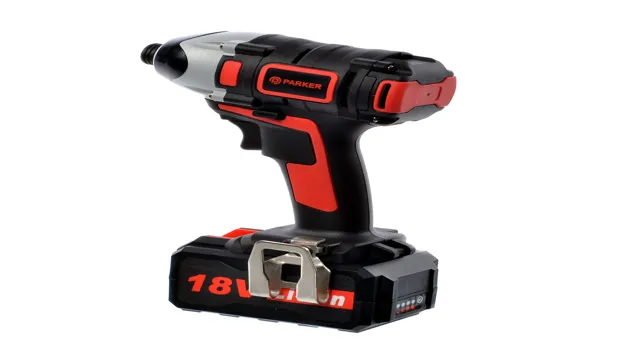
Advantages and Disadvantages of Hammer Drills and Impact Drivers
When it comes to completing DIY projects or home repairs, having the right tools for the job is crucial. Two popular options are hammer drills and impact drivers. A hammer drill works by using a rolling mechanism to pound the drill bit into the material while spinning it.
This helps to break up tough surfaces, such as concrete or brick. On the other hand, an impact driver utilizes rotational force to drive screws quickly and efficiently, making it ideal for tasks like building a deck or installing cabinetry. While both tools have their advantages, they also have some disadvantages to consider.
For example, hammer drills can be heavy and produce a lot of noise, which may not be suitable for some projects. Impact drivers can be less precise and more likely to cause damage if used improperly. Ultimately, it’s important to evaluate your needs and the task at hand before deciding which tool to use.
Using a Hammer Drill as an Impact Driver
Yes, you can use a hammer drill as an impact driver, but keep in mind that these tools are designed for different tasks. A hammer drill is mainly used for drilling into harder materials such as concrete or masonry, while an impact driver is designed to drive screws and fasteners into wood or metal with ease. The hammer drill’s primary function is to hammer the bit forward while drilling, while the impact driver uses a rotational force to drive in screws quickly.
The hammer drill’s hammering action can be too forceful for delicate materials and cause damage. However, some hammer drill models come with a clutch that helps regulate the force, allowing you to use it as an impact driver effectively. If your hammer drill lacks a clutch, you can try using it with a hex-shank adapter to drive in screws.
Just keep in mind that there may be limits on its effectiveness and potential damage to the tool’s gears and mechanisms. In summary, using a hammer drill as an impact driver is possible, but it is essential to understand the limits of the tool and use caution to prevent unnecessary damage.
When and How to Use a Hammer Drill as an Impact Driver
Hammer drill When it comes to DIY projects, owning multiple power tools can make your life much easier. However, if you’re trying to save money and space, you may be wondering if you can use your hammer drill as an impact driver. Overall, hammer drills and impact drivers have different purposes, but there are some situations where you can use a hammer drill as an impact driver.
For example, if you need to drive screws into masonry walls, you can attach a hex bit to your hammer drill and use it to drive the screws. Just make sure to use a low torque setting and start slowly to prevent damage to the drill and the surface you’re working on. However, keep in mind that hammer drills are not designed for repetitive driving tasks, and they may not be as comfortable to use as impact drivers for prolonged periods.
So, while you can use a hammer drill as an impact driver in some cases, it’s often best to use each tool for their intended purpose.
Steps to Use a Hammer Drill as an Impact Driver
If you’re looking to use a hammer drill as an impact driver, you’re in luck. While both tools have different purposes, it’s possible to use a hammer drill as an impact driver in a pinch. The first step is to attach a hex-shank bit to the chuck, just as you would with an impact driver.
This will allow the drill to fit standard screwdriver bits. It’s crucial to ensure that the bit is secure and well-seated before moving on to the next step. Once the bit is in place, you can set the drill to the screwdriver setting and adjust the clutch to your desired level of torque.
While using a hammer drill as an impact driver may not be ideal, it can be an effective solution when you don’t have an impact driver on hand. Just remember to be patient and take your time to avoid damaging the tool or your project.
Impact Driver Bit Compatibility with Hammer Drills
When it comes to using a hammer drill as an impact driver, compatibility between the two is essential. While hammer drills and impact drivers share some similarities in function, using an impact driver bit with a hammer drill may not always work. Compatibility depends on the bit’s shank design and the drill’s chuck size.
A hammer drill typically has a keyed or keyless chuck designed for use with drill bits that have flatted shanks. In contrast, impact driver bits usually have hexagonal shanks, allowing for more torque power. However, you can use an impact driver bit with a hammer drill by using a chuck adapter.
This adapter will allow you to switch between the different types of shanks, making your hammer drill compatible with impact driver bits. Keep in mind that using an impact driver bit with a hammer drill may not provide the same level of torque as an actual impact driver, so it’s best to use the right tool for the job.
Risks and Precautions of Using Hammer Drills as Impact Drivers
Using a hammer drill as an impact driver may seem like a smart idea, but it can be a risky move if you are not aware of its limitations. Hammer drills are designed to provide tremendous force for drilling through tough materials like concrete and masonry. They have a percussion feature that helps break up the material, making it easier to drill through.
Impact drivers, on the other hand, are specifically designed for driving screws and bolts. They are great for speeding up projects and saving time, but they lack the power of hammer drills. One of the main risks of using a hammer drill as an impact driver is that it can damage your project or the drill itself.
The high torque and force of a hammer drill can easily strip screws or bolts and cause damage to the material you’re working with. Additionally, hammer drills are not designed to handle the fine-tuned precision of driving screws. This can lead to overdriving or underdriving screws, which can also damage your project.
To avoid these risks, it is important to use the right tool for the job. Another precaution to keep in mind is that hammer drills and impact drivers have different bits. While some bits may be interchangeable, most are not.
Using the wrong bit on your tool can cause damage and increase the likelihood of injuries. It’s important to use the correct bit for each tool to get the best results and reduce the risk of accidents. In conclusion, while hammer drills and impact drivers may seem similar, they are designed for different applications.
While you technically can use a hammer drill as an impact driver, it is not recommended. It can lead to costly damage, injuries, and a lot of frustration. Instead, invest in the right tool for the job, and you’ll be able to work safely and efficiently.
Safety Tips
Hammer drills are excellent for drilling into tough materials, but when used as impact drivers, they can pose several risks. One of the most significant risks is the potential for the hammer drill bit to slip and cause injury. To mitigate this risk, always make sure the bit is properly locked in place before using the tool.
Additionally, hammer drills can generate a lot of vibration, which can lead to hand fatigue and even long-term nerve damage if used frequently. To reduce these risks, consider using gloves with padding or a vibration-reducing grip when working with hammer drills. Another crucial precaution is to always wear safety glasses to protect your eyes from debris, and earplugs to prevent hearing damage from the noise generated by the impact driving action.
By taking these safety measures, you can safely use hammer drills as impact drivers and confidently complete your projects with ease.
Potential Damages to the Hammer Drill and Impact Driver
Using a hammer drill as an impact driver can lead to potential damages that may become costly to repair. The hammer drill may not be designed to withstand the repetitive and sudden rotational force generated by the impact driver, and this can lead to premature failure of the drill. Furthermore, using hammer drill bits with an impact driver can result in breakage or extreme wear and tear due to the increased force generated by the impact driver.
To prevent such damages, it is crucial to ensure that you use the right tool for the job. Always refer to the manufacturer’s instructions and recommended applications before using any power tool. It’s also essential to invest in the appropriate impact-rated driver bits that are designed to handle the sudden impact force without breaking or wearing out.
Taking these precautions will not only ensure your tool’s longevity but also your safety as a user.
Conclusion
In the world of power tools, it’s important to use the right tool for the job. While a hammer drill and an impact driver may look similar, they serve different purposes. So, can you use a hammer drill as an impact driver? The answer is a resounding no! It’s like asking if you can use a banana as a hammer – technically, you could try, but it’s not going to work out very well.
So save yourself the headache (literally) and invest in both tools to ensure you’re always getting the job done right.”
FAQs
What is the difference between a hammer drill and impact driver?
A hammer drill is designed for drilling into hard surfaces like concrete and masonry and combines rotary drilling with a hammering action. An impact driver, on the other hand, is designed for fastening and loosening bolts, screws, and other hardware. It delivers high torque and rotational force to drive screws without stripping the heads.
Can you use an impact driver for drilling?
While an impact driver is primarily designed for fastening, it can also be used for drilling small holes in soft materials like wood, plastic, and thin metal. However, it is not recommended for drilling hard materials like concrete and masonry since it lacks the rotary hammer action of a hammer drill.
Can you use a hammer drill as an impact driver?
No, a hammer drill cannot replace an impact driver since they serve different purposes. While a hammer drill can be used for drilling holes and driving screws, it lacks the high torque and rotational force of an impact driver necessary for fastening and loosening bolts, nuts, and other hardware.
What are the advantages of using an impact driver over a drill?
An impact driver offers several advantages over a drill, including higher torque, greater rotational force, reduced user fatigue, and faster driving speed. It also has a quick-change chuck system that allows for easy bit changes and a compact size that makes it ideal for tight spaces.
Do I need special bits for an impact driver?
Yes, you need special impact-rated bits for best performance and to prevent damage to the driver and bits. Impact-rated bits are designed to withstand the high torque and rotational force of an impact driver and have a unique tip geometry that reduces stripping and slipping of the screw head.
Can an impact driver replace a cordless drill?
An impact driver can replace a cordless drill in many applications since it can drill small holes and drive screws with higher torque and rotational force. However, it lacks the precision and versatility of a drill for drilling larger holes, countersinking, and other tasks. Therefore, it is recommended to own both tools for best results.
Are impact drivers louder than drills?
Yes, impact drivers are generally louder than drills due to the hammering action that produces a loud whirring noise. However, many models come with built-in noise-reduction technology and are designed to be less noisy and more comfortable to use for extended periods.

